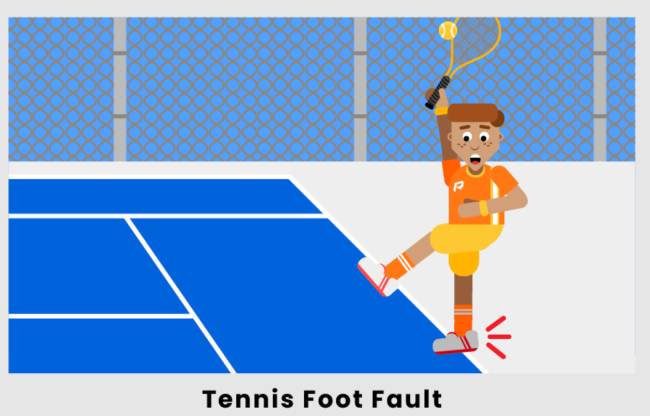An invalid serve attempt in tennis is caused by a violation committed by the server or the player returning the serve. This violation is witnessed and called by the umpire or line judge. A fault can seem effortless during a match, but most players consider it a mistake. Additionally, they put a lot of effort into avoiding a second error.
Table of Contents
What are Considered Faults in Tennis?
During a tennis match, faults can occur in several ways. When watching a game, fans should be aware of these faults.
- Tennis balls fail to clear the net or bounce somewhere other than the service box on the other side of the court, which is the first sign of a fault.
- In addition, an umpire may see an illegal release of the ball if a player swings for a serve and misses the ball. Tennis players are supposed to release the ball from one hand unless they are one-handed, in which case they can use their racquet to release the ball. If they miss the swing, or release the ball, in any other way, they are penalized.
- Finally, if the ball hits anything other than the net cord, the player’s body, or racquet before it bounces, it is considered a fault. As an example, if a ball hits the net post but still finds its way into the correct court, it is still considered a fault.
Is a Fault a Point in Tennis?
When a player commits a fault on their first serve, they do not receive a point. As a result, they receive a second serve, but if a fault occurs on the second serve, the opponent gets the point. Theoretically, players can lose a match if they commit two faults in a row, but that rarely happens in professional tennis.

What are Normal Faults, Foot Faults, and Double Faults in Tennis?
Tennis players can commit several different faults for a variety of reasons. A normal fault, a foot fault, and a double fault are the different types of faults. The following is a breakdown of each of these three tennis faults.
Foot Fault
In tennis, a foot fault occurs when the player’s serve is positioned incorrectly.
When a player prepares to serve, their front foot can only touch the ground behind the baseline, between the extension of the center line and the sideline. Furthermore, according to ATP rules, players must remain in the same position while serving; they cannot build momentum with their feet.
Double Fault
When one of the errors mentioned in the previous section occurs on both the first and second serve, a double fault is called, and the opponent receives the point. As the point of tennis is to keep the game going and fair, every player has two serves to get it right, but if the player messes up on the second serve, the point is lost.
Final Fault
A normal fault is the final type of fault. A fault can occur for any number of reasons, such as swinging at the ball and missing or illegally releasing it.
What is the Difference Between a Fault and a Double Fault?
In the case of a fault, a player still has one more chance to serve and to start a rally, unlike a double fault. Next, the opponent serves for the next point after receiving the point on a double fault.
In tennis, a fault is more common than a double fault. Professional tennis players know how to readjust, so single faults are more common.
Can You Lose a Tennis Match on a Double Fault?
During a rally, a double fault is like hitting a tennis ball out of bounds. When the ball lands out during a rally, a player can lose the match, just as when he or she double faults. Even so, it is rare for a player to lose a match due to a double fault, especially in championship matches.
In 2014, Rafael Nadal won a match on a double fault committed by Novak Djokovic during the French Open, the second time he had a game on a double fault. In 2012, he also won after Djokovic committed a double fault.
Conclusion: What is a Fault in Tennis?
A fault, regardless of how it occurred during a tennis match, is an enormous blunder. Committing a fault shows a lack of focus and discipline. Double faults don’t occur that often because players readjust themselves after the first time and take their time to ensure the serve is successful.
Serves can be one of the deciding factors in a tennis match. Tennis rules place so many restrictions on how a server can commit a serve, such as where the server’s feet must set, that it can be difficult for players to commit a serve. In light of this, serving is one of the best tools a player can use against an opponent.
Lastly, professional tennis games are rarely decided by double faults. Nevertheless, when it happens, it creates headlines, as it did in 2014. The double fault Novak Djokovic committed to lose to Nadal made headlines, but in the wrong way.
FAQs
During a tennis match, players have two chances to serve a ball into the correct service box. A fault occurs when a player loses their first serve. The subsequent loss of their second serve is a double fault, which results in the point being lost.
In a game, the first serve must go over the net and into the receiver’s right (deuce) service court. It’s called a “fault” if you don’t serve into the correct box on your first serve. If you miss your second serve, it’s called a “double fault” and your opponent wins the point.
